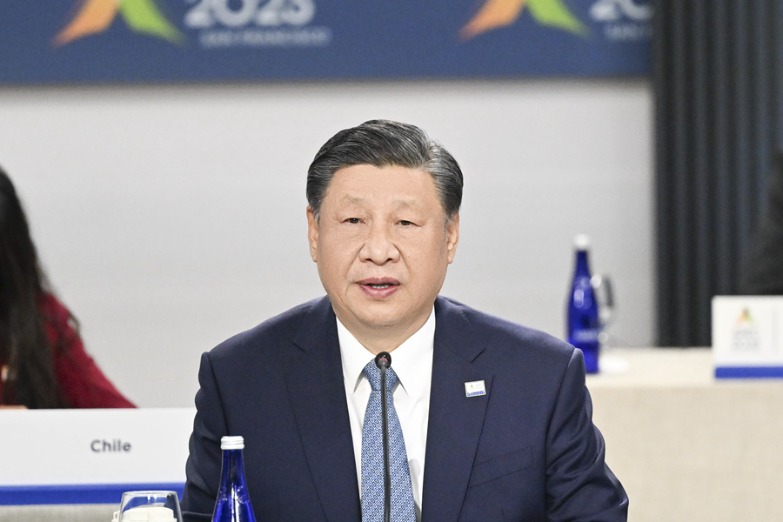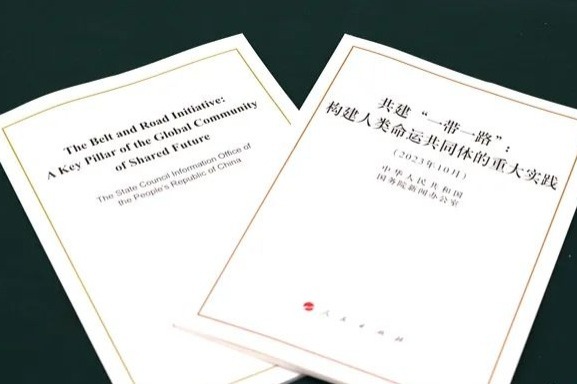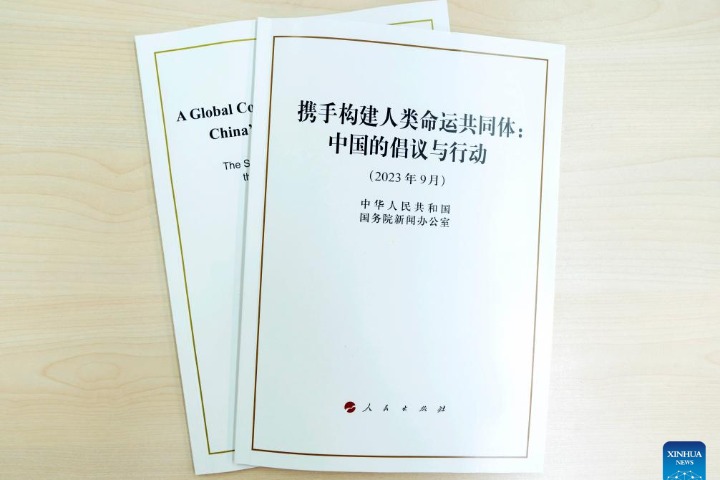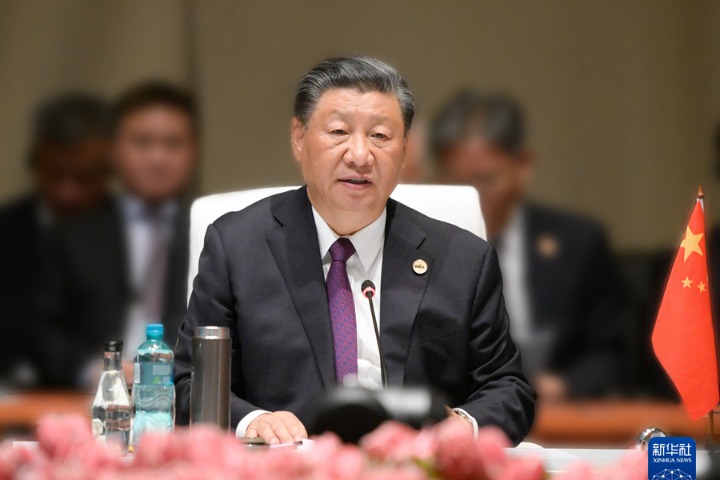《中国的生物多样性保护》白皮书(双语全文)
新华网 2021-10-09 09:17

四、深化全球生物多样性保护合作
IV. Further Global Cooperation on Biodiversity Conservation
面对生物多样性丧失的全球性挑战,各国是同舟共济的命运共同体。中国坚定践行多边主义,积极开展生物多样性保护国际合作,广泛协商、凝聚共识,为推进全球生物多样性保护贡献中国智慧,与国际社会共同构建人与自然生命共同体。
Facing the global challenge of biodiversity loss, all countries form a community of shared future. China firmly practices multilateralism and actively carries out international cooperation on biodiversity conservation through extensive consultations to build consensus. It is contributing solutions to global biodiversity conservation and working together with the international community to build a shared future for humanity and nature.
(一)积极履行国际公约
1. Actively Implementing International Conventions
中国积极履行《生物多样性公约》及其议定书,促进相关公约协同增效,展现大国担当,在全球生物多样性保护和治理进程中发挥重要作用。
By actively implementing the Convention on Biological Diversity and related protocols, with a strong sense of responsibility as a major country, China has worked to enhance synergies among biodiversity-related conventions and played an important role in global biodiversity conservation and governance.
积极履行《生物多样性公约》及其议定书。1992年以来,中国坚定支持生物多样性多边治理体系,采取一系列政策和措施,切实履行公约义务。作为公约及其议定书的缔约方,按时高质量提交国家报告,2019年7月提交了《中国履行〈生物多样性公约〉第六次国家报告》,同年10月提交了《中国履行〈卡塔赫纳生物安全议定书〉第四次国家报告》。2019年以来,中国成为《生物多样性公约》及其议定书核心预算的最大捐助国,有力支持了《生物多样性公约》的运作和执行。近年来,中国持续加大对全球环境基金捐资力度,已成为全球环境基金最大的发展中国家捐资国,有力地支持了全球生物多样性保护。
Actively implementing the Convention on Biological Diversity and related protocols. China firmly supports the multilateral governance system for biodiversity, and has adopted strong policies and measures to fulfill its obligations under the Convention since 1992. As an important signing party of the Convention and its protocols, China has submitted high-quality national reports on a regular basis. In July 2019, China submitted its Sixth National Report to the Convention on Biological Diversity and in October the Fourth National Report to the Cartagena Protocol on Biosafety.
Since 2019 China has been the largest contributor to the core budget of the Convention and its protocols, and has strongly supported its operation and implementation. In recent years, China has continued to increase its contributions to the Global Environment Facility (GEF), and has become the largest developing country contributor to the GEF, lending strong support to global biodiversity conservation.
促进生物多样性相关公约协同增效。生物多样性与其他生态环境问题联系密切,中国支持协同打造更牢固的全球生态安全屏障,构筑尊重自然的生态系统,协同推动《生物多样性公约》与其他国际公约共同发挥作用。中国持续推进《濒危野生动植物种国际贸易公约》《联合国气候变化框架公约》《联合国防治荒漠化公约》《关于特别是作为水禽栖息地的国际重要湿地公约》《联合国森林文书》等进程,与相关国际机构合作建立国际荒漠化防治知识管理中心,与新西兰共同牵头组织“基于自然的解决方案”领域工作,并将其作为应对气候变化、生物多样性丧失的协同解决方案。2020年9月,中国宣布力争2030年前实现碳达峰、2060年前实现碳中和,为全球应对和减缓气候变化作出中国贡献。
Enhancing synergies among biodiversity-related conventions. Biodiversity is closely related to other eco-environmental issues. China supports collaborative efforts in building a stronger global ecological security barrier and an ecosystem that respects nature, and is ready to work with all the parties to push for a joint role for the Convention and other international conventions.
China takes an active part in implementing the Convention on International Trade in Endangered Species of Wild Fauna and Flora, the United Nations Framework Convention on Climate Change, the United Nations Convention to Combat Desertification, the Convention on Wetlands of International Importance Especially as Waterfowl Habitat, and the documents of the UN Forum on Forests. In cooperation with relevant international organizations, China has established the International Desertification Control Knowledge Management Center. China and New Zealand jointly led the efforts on Nature-based Solutions (NBS) projects, making NBS a synergistic solution in combating climate change and biodiversity loss.
In September 2020, China announced that it will strive to peak carbon emissions by 2030 and achieve carbon neutrality by 2060, contributing its share to the global response to climate change mitigation.
推动履约取得明显成效。中国为推动实现2020年全球生物多样性保护目标和联合国2030年可持续发展目标作出积极贡献。自发布《中国生物多样性保护战略与行动计划》(2011-2030年)以来,中国通过完善法律法规和体制机制、加强就地和迁地保护、推动公众参与、深化国际合作等政策措施,有力推动改善了生态环境。其中,设立陆地自然保护区、恢复和保障重要生态系统服务、增加生态系统的复原力和碳储量等3项目标超额完成,生物多样性主流化、可持续管理农林渔业、可持续生产和消费等13项目标取得良好进展。
Achieving remarkable results in fulfilling obligations. China has made positive contribution to the 2020 global biodiversity targets (the Aichi targets) and the United Nations 2030 Sustainable Development Goals.
In 2010, the China National Biodiversity Conservation Strategy and Action Plan (2011-2030) was published. Since then, China has been working for a better eco-environment by improving the legal system and other mechanisms, strengthening in-situ and ex-situ conservation, increasing public participation, and boosting international cooperation and exchanges on biodiversity.
China has over-fulfilled three of the Aichi targets – establishing terrestrial nature reserves, restoring and ensuring important ecosystem services, and increasing ecosystem resilience and carbon storage – and made progress in 13 targets, including mainstreaming biodiversity, sustainable management of agriculture, forestry and fishery, and sustainable production and consumption.
(二)增进国际交流合作
2. Strengthening International Exchanges and Cooperation
中国坚持多边主义,注重广泛开展合作交流,凝聚全球生物多样性保护治理合力。借助“一带一路”“南南合作”等多边合作机制,为发展中国家保护生物多样性提供支持,努力构建地球生命共同体。
China is an advocate of multilateralism. It engages in extensive cooperation and exchanges, pooling global forces in biodiversity conservation and governance. With the help of multilateral cooperation mechanisms such as the Belt and Road Initiative (BRI) and South-South Cooperation, China has provided support for biodiversity conservation in developing countries and is striving to build a shared future for all life on Earth.
建立“一带一路”绿色发展多边合作机制。中国将生态文明领域合作作为高质量共建“一带一路”重点内容,采取绿色基建、绿色能源、绿色金融等系列举措,为沿线国家提供资金、技术、能力建设等方面支持,帮助他们加速绿色低碳转型,持续造福沿线各国人民。成立“一带一路”绿色发展国际联盟,40多个国家成为合作伙伴,在生物多样性保护、全球气候变化治理与绿色转型等方面开展合作。建设“一带一路”生态环保大数据服务平台,吸纳100多个国家生物多样性相关数据,为“一带一路”绿色发展提供数据支持。实施绿色丝路使者计划,与发展中国家共同加强环保能力建设,通过开展培训、项目合作等形式,为有关国家落实《联合国2030年可持续发展议程》提供帮助。
Establishing multilateral cooperation mechanisms for green development under the BRI. China regards cooperation in eco-civilization as a key component of the BRI, and has adopted a series of green measures in infrastructure, energy, and finance to support participating countries with fund, technology and capacity building. These measures are helping them transform faster to green, low-carbon growth to the benefit of the people.
China has established the Belt and Road Initiative International Green Development Coalition, with international partners from over 40 countries. The Coalition facilitates cooperation on biodiversity conservation, global climate change governance and green transformation.
The BRI Environment Big Data Platform is in the making. The platform aims to collect biodiversity data from over 100 countries and provides data in support of the initiative’s green development.
A Green Silk Road Envoy Program has been launched to jointly build environmental protection capacity with other developing countries. Under the program, China has helped relevant countries, through training and other project cooperation, to implement the United Nations 2030 Agenda for Sustainable Development.
深化生物多样性保护“南南合作”。中国在“南南合作”框架下积极为发展中国家保护生物多样性提供支持,全球80多个国家受益。建立澜沧江-湄公河环境合作中心,定期举行澜沧江-湄公河环境合作圆桌对话,围绕生态系统管理、生物多样性保护等议题进行交流。建立中国-东盟环境合作中心,与东盟国家合作开发和实施“生物多样性与生态系统保护合作计划”“大湄公河次区域核心环境项目与生物多样性保护走廊计划”等项目,在生物多样性保护、廊道规划和管理以及社区生计改善等方面取得丰硕成果。建立中国科学院东南亚生物多样性研究中心,开展联合科学考察、重大科学研究、政策咨询与人才培养等工作。建立中非环境合作中心,促进环境技术合作,共享绿色发展机遇。
Stepping up South-South cooperation. China has provided support for more than 80 developing countries in biodiversity conservation under the framework of South-South cooperation.
China has established a center for the Lancang-Mekong environmental cooperation, and hosted regular roundtable meetings with a focus on ecosystem management and biodiversity conservation. It has set up the China-ASEAN Environmental Cooperation Center, and launched and implemented with ASEAN member states a number of cooperation initiatives, including the China-ASEAN Cooperation Plan on Biodiversity and Ecological Conservation, and the Core Environment Program and Biodiversity Conservation Corridors Initiative in the Greater Mekong Subregion. Fruitful results have been achieved in biodiversity conservation, corridor planning and management, and community livelihood improvement. The Southeast Asia Biodiversity Research Institute of the Chinese Academy of Sciences (CAS-SEABRI) was unveiled in 2015 to carry out joint field studies, major scientific research, policy consultation, and personnel training. The China-Africa Environment Cooperation Center has been established for cooperation on environmental technology and for sharing green development opportunities.
广泛开展双多边合作。坚持共商共建共享原则,不断深化生物多样性领域对外合作。积极参加联合国生物多样性峰会、领导人气候峰会等国际会议及活动,为保护生物多样性、促进可持续发展注入动力。组织召开“2020年后全球生物多样性展望:共建地球生命共同体”部长级在线圆桌会,共商2020年后生物多样性全球治理。中法两国共同发布《中法生物多样性保护和气候变化北京倡议》。与俄罗斯、日本等国家展开候鸟保护的长期合作。与俄罗斯、蒙古国、老挝、越南等国家合作,建立跨境自然保护地和生态廊道,其中,中俄跨境自然保护区内物种数量持续增长,野生东北虎开始在中俄保护地间自由迁移;中老跨境生物多样性联合保护区面积达20万公顷,有效保护亚洲象等珍稀濒危物种及其栖息地。中国还与德国、英国、南非等分别建立双边合作机制,就生物多样性和生态系统服务、气候变化和生物安全等领域开展广泛的合作与交流,与日本、韩国建立中日韩三国生物多样性政策对话机制。
Carrying out extensive bilateral and multilateral cooperation. Following the principles of extensive consultation, joint contribution and shared benefits, China has constantly expanded biodiversity cooperation.
It has taken an active part in international conferences and activities, including the United Nations Summit on Biodiversity and the Leaders’ Summit on Climate, giving impetus to biodiversity conservation and sustainable development. In 2020, China organized an online ministerial roundtable “Biodiversity Beyond 2020: Building a Shared Future for All Life on Earth” to discuss global biodiversity governance after 2020.
China and France jointly issued the Beijing Call for Biodiversity Conservation and Climate Change in 2019. China carries out long-term cooperation on migratory bird protection with Russia, Japan and other countries. China has worked with Russia, Mongolia, Laos, Vietnam and other countries in establishing transboundary PAs and ecological corridors. The number of species in the China-Russia transboundary nature reserve continues to grow, and wild Siberian tigers are beginning to migrate freely between PAs in Russia and China. The China-Laos transboundary biodiversity reserve, with an area of 200,000 hectares, effectively protects rare and endangered species such as Asian elephants and their habitats. China has established bilateral cooperation mechanisms with Germany, the United Kingdom, South Africa, and some other countries, through which extensive cooperation and exchanges on biodiversity and ecosystem services, climate change, and biosecurity have been carried out. It has established a mechanism of tripartite policy dialogue on biodiversity with Japan and the ROK.
结束语
Conclusion
地球是人类共同生活和守护的家园,生物多样性是人类赖以生存和发展的基础,是地球生命共同体的血脉和根基。面对生物多样性丧失的全球性挑战,全人类是休戚与共的命运共同体。
The Earth is the homeland of humanity and we should protect it together. Biodiversity is the foundation for human survival and development, and the bloodline of all life on Earth. Facing the global challenge of biodiversity loss, humanity is one community that shares one and the same future.
中国已经踏上全面建设社会主义现代化国家的新征程,生态文明建设具备更多条件,同时,也面临很多挑战,生物多样性保护任重而道远。展望未来,中国将秉持人与自然生命共同体理念,把生物多样性保护作为生态文明建设重要内容,持续推进生物多样性治理体系和治理能力现代化,改善自然生态系统状况,提升生态服务功能,提高生态产品供给能力,实现自然生态系统良性循环,不断满足人民日益增长的优美生态环境需求。
On its new journey towards a modern socialist country, China is now equipped with better resources for boosting eco-civilization. But it also faces many challenges and heavy tasks. Looking to the future, China will uphold the idea of a shared future for humanity and nature, treat biodiversity conservation as an important part of eco-civilization, and continue to modernize its biodiversity governance system and capabilities. It will work to improve natural ecosystems, reinforce eco-environmental services, and provide more eco-environmental products, to achieve a virtuous cycle of natural ecosystems and meet the people’s growing demand for a beautiful eco-environment.
中国将始终做万物和谐美丽家园的维护者、建设者和贡献者,与国际社会携手并进、共同努力,开启更加公正合理、各尽所能的全球生物多样性治理新进程,实现人与自然和谐共生美好愿景,推动构建人类命运共同体,共同建设更加美好的世界。
China will always stand guard for our harmonious and beautiful planet for all life and contribute to its wellbeing with action. It will work together with the international community on a new model of global biodiversity governance that is fairer and more reasonable, with each member contributing its share, so as to realize the worldwide vision of harmonious coexistence between humanity and nature. It will continue to help build a global community of shared future, and move forward into better times with the rest of the world.

















 英语点津微信
英语点津微信 双语小程序
双语小程序